Real Time Soil Moisture (RTSM) Based Irrigation Scheduling to Improve Yield and Water-Use Efficiency of Green Pea (Pisum sativum L.) Grown in North India
Abstract
:1. Introduction
2. Materials and Methods
2.1. Experimental Details
2.2. Field Preparation and Seed Sowing
2.3. Soil Matric Potential Measurement
2.4. Details of Irrigation and Fertigation Levels
2.5. Plant Growth and Yield Parameters
2.6. Water-Use Efficiency
2.7. Statistical Analysis
3. Results and Discussion
3.1. Soil Matric Potential Range under Different Treatments
3.2. Soil Moisture Distribution under Different Soil Matric Potential
3.3. Irrigation Scheduling for Green Pea
3.4. Green Pea Growth, Quality Parameters, and Analysis of Variance
3.5. Descriptive Statistics of Plant Growth Parameters
3.6. Effect of Irrigation and Fertilizer Treatments on Pea Yield
3.7. Effect of Irrigation and Fertilizer Treatments on Water-Use Efficiency
3.8. Estimates of Correlation between Plant Growth Parameters
3.9. Regression Models for Prediction of Yield through Different Parameters
4. Conclusions
Author Contributions
Funding
Institutional Review Board Statement
Informed Consent Statement
Data Availability Statement
Acknowledgments
Conflicts of Interest
References
- Duzdemir, O.; Kurunc, A.; Unlukara, A. Response of pea (Pisum sativum) to salinity and irrigation water regime. Bulg. J. Agric. Sci. 2009, 15, 400–409. [Google Scholar]
- Alvino, A.; Leone, A. Response to low soil water potential in pea genotypes (Pisum sativum L.) with different leaf morphology. Sci. Hortic. 1993, 53, 21–34. [Google Scholar] [CrossRef]
- Santos, O.F.; Cunha, F.F.; Taira, T.L.; Souza, E.J.; Leal, A.J. Increase in pea productivity associated with irrigation management. Hortic. Bras. 2018, 36, 178–183. [Google Scholar] [CrossRef]
- Gu, Z.; Qi, Z.; Burghate, R.; Yuan, S.; Jiao, X.; Xu, J. Irrigation Scheduling Approaches and Applications: A Review. J. Irrig. Drain. Eng. 2020, 146, 04020007. [Google Scholar] [CrossRef]
- Munoz-Carpena, R.; Dukes, M.D.; Li, Y.C.; Klassen, W. Field comparison of tensiometer and granular matrix sensor automatic drip irrigation on tomato. HortTechnology 2005, 15, 584–590. [Google Scholar] [CrossRef] [Green Version]
- Osman, H.S. Enhancing antioxidant–yield relationship of pea plant under drought at different growth stages by exogenously applied glycine betaine and proline. Ann. Agric. Sci. 2015, 60, 389–402. [Google Scholar] [CrossRef] [Green Version]
- Shock, C.C.; Wang, F.X. Soil water Tension, a powerful measurement for productivity and stewardship. HortScience 2011, 46, 178–185. [Google Scholar] [CrossRef] [Green Version]
- Wang, D.; Kang, Y.; Wan, S. Effect of soil matric potential on tomato yield and water use under drip irrigation condition. Agric. Water Manag. 2007, 87, 180–186. [Google Scholar] [CrossRef]
- Whalley, W.R.; Ober, E.S.; Jenkins, M. Measurement of the matric potential of soil water in the rhizosphere. J. Exp. Bot. 2013, 64, 3951–3963. [Google Scholar] [CrossRef] [Green Version]
- Lailhacar, B.C.; Dukes, M.D.; Miller, G.L. Sensor based automation of irrigation on bermuda grass during dry weather conditions. J. Irrig. Drain. Eng. 2010, 136, 184–193. [Google Scholar] [CrossRef] [Green Version]
- Marwa, M.A.; Abdelraouf, R.E.; Wahba, S.A.; El-Bagouri, K.F.; El-Gindy, A.G. Scheduling Irrigation using automatic tensiometers for pea crop. Agric. Eng. Int. CIGR J. 2017, 19, 174–183. Available online: http://www.cigrjournal.org (accessed on 20 November 2021).
- Khan, J.N.; Jain, A.K.; Singh, V.P.; Kumar, R.; Sharda, R.; Siag, M. Simulation of Mulch and No-Mulch Conditions for Various Soil Matric Potential Thresholds for Drip-Fertigated Guava (Psidium guajava L.) in the Semiarid Region of Northwest India. J. Irrig. Drain. Eng. 2016, 142, 04016040. [Google Scholar] [CrossRef]
- Gomez, K.A.; Gomez, A. Statistical Procedures for Agricultural Research, 2nd ed.; John Wiley Publications Inc.: New York, NY, USA, 1984. [Google Scholar]
- Snedecor, G.W.; Cochran, W.G. Statistical Methods, 8th ed.; Iowa State University Press: Iowa city, IA, USA, 1989. [Google Scholar]
- Draper, N.R.; Smith, H. Applied Regression Analysis; John Wiley Publications Inc.: New York, NY, USA, 1998. [Google Scholar]
- Lozoya, C.; Mendoza, C.; Aguilar, A.; Roman, A.; Castello, R. Sensor-Based Model Driven Control Strategy for Precision Irrigation. J. Sens. 2016, 2016, 9784071. [Google Scholar] [CrossRef] [Green Version]
- Adeyemi, O.; Grove, I.; Peets, S.; Domun, Y.; Norton, T. Dynamic Neural Network Modelling of Soil Moisture Content for Predictive Irrigation Scheduling. Sensors 2018, 18, 3408. [Google Scholar] [CrossRef] [PubMed] [Green Version]
- Satpute, S.T.; Singh, M.; Khanna, M.; Singh, A.K.; Ahmad, T. Response of drip irrigated onion crop to irrigation intervals and fertigation strategies. Indian J. Hortic. 2013, 70, 293–295. [Google Scholar]
- Sadik, S.K.; AL-Taweel, A.A.; Dhyeab, N.S. New computer program for estimating leaf area of several vegetable crops. Am.-Eurasian J. Sustain. Agric. 2011, 5, 304–309. [Google Scholar]
- Singh, K.G.; Siag, M.; Mahajan, G. Irrigation water requirements of green pea. In Best Management Practices for Drip Irrigated Crops; Singh, K.G., Goyal, M.R., Rudra, R.P., Eds.; Apple Academic Press: Boca Raton, FL, USA, 2015; pp. 261–267. [Google Scholar] [CrossRef]
- Sharma, D.; Chauhan, A.; Jarial, K. Performance of Pea Varieties in Different Altitude Ranges under North-Western Himalayan Region. Int. J. Curr. Microbiol. Appl. Sci. 2020, 9, 3292–3302. [Google Scholar] [CrossRef]
- Rao, K.V.R.; Gangwar, S.; Bajpai, A.; Keshri, R.; Chourasia, L.; Soni, K. Performance of pea under different irrigation systems. Legume Res. 2017, 40, 559–561. [Google Scholar] [CrossRef]
- Singh, K.G.; Siag, M.; Mahajan, G. Water and nutrient requirement of drip irrigated green pea. Haryana J. Hortic. Sci. 2006, 35, 320–322. [Google Scholar]
- Ali, A.; Alfarhan, A.; Aldjain, I.; Bokhari, N.; Al-Taisan, W.; Al-Rasheid, K.; Al-Quraishi, S. Photosynthetic responses of pea plants (Pisum sativum L. cv. Little marvel) exposed to climate change in Riyadh city, KSA. Afr. J. Biotechnol. 2008, 7, 2630–2636. [Google Scholar]
- Wahba, S.A.; El-Gindy, A.M.; El-Bagouri, K.F.; Marwa, M.A. Response of Green Peas to Irrigation Automatic Scheduling and Potassium Fertigation. Int. J. ChemTech Res. 2016, 9, 228–236. [Google Scholar]
- Liu, H.; Yin, C.; Gao, Z.; Hou, L. Evaluation of cucumber yield, economic benefit and water productivity under different soil matric potentials in solar greenhouses in North China. Agric. Water Manag. 2021, 243, 106442. [Google Scholar] [CrossRef]
- Saroch, K.; Sandal, S.K.; Rana, K. Effect of irrigation scheduling and NK fertigation on productivity of garden peas (Pisum sativum var. hortenseL.). Himachal J. Agric. Res. 2015, 41, 126–131. [Google Scholar]
- Nassar, A.A.; El Azem, A.A.M. Irrigation Technologies for improving salt distribution, pea production and water relations. Misr J. Agric. Eng. 2006, 23, 1175–1189. [Google Scholar]
- Gan, Y.T.; Wang, J.; Bing, D.J.; Miller, P.R.; McDonald, C.L. Water use of pulse crops at various plant densities under fallow and stubble conditions in a semiarid environment. Can. J. Plant Sci. 2007, 87, 719–722. [Google Scholar] [CrossRef]
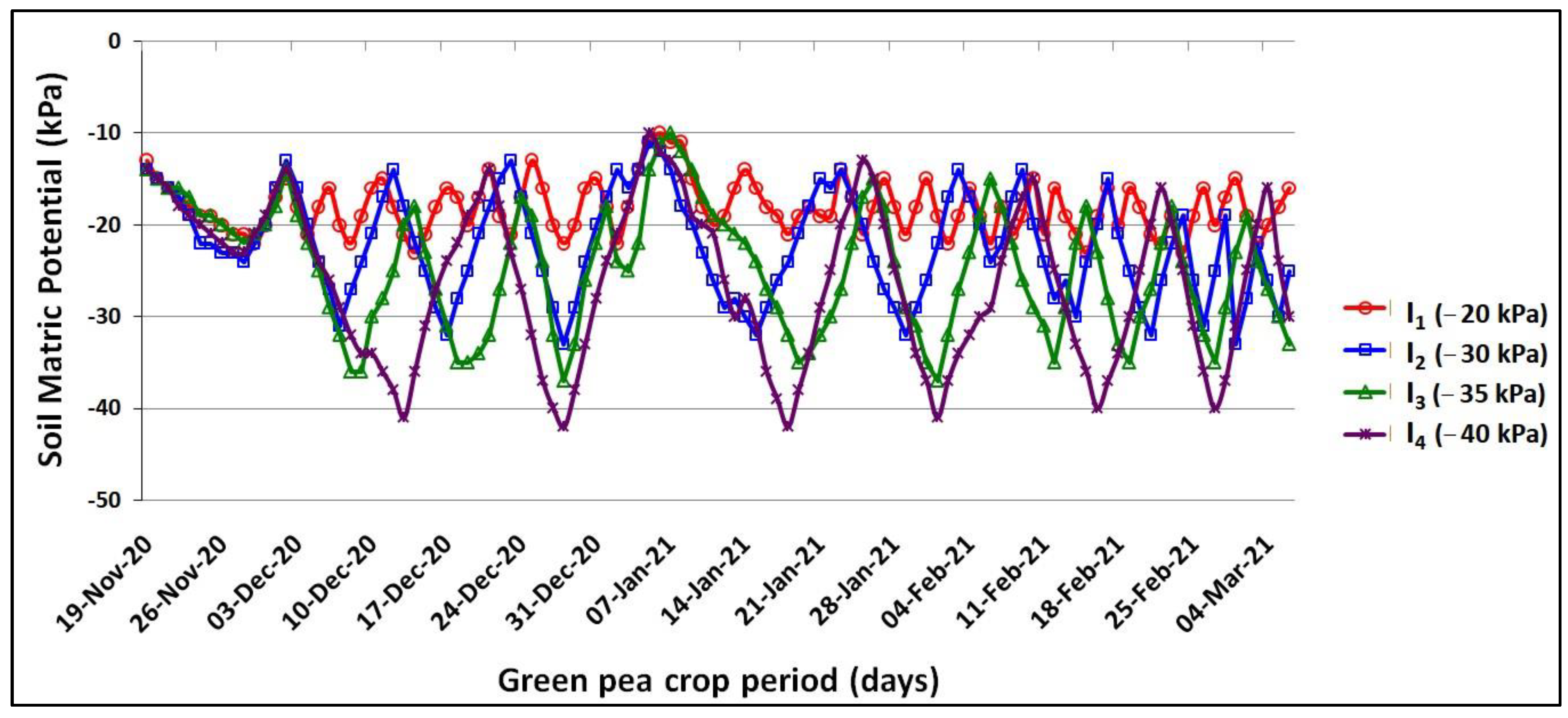
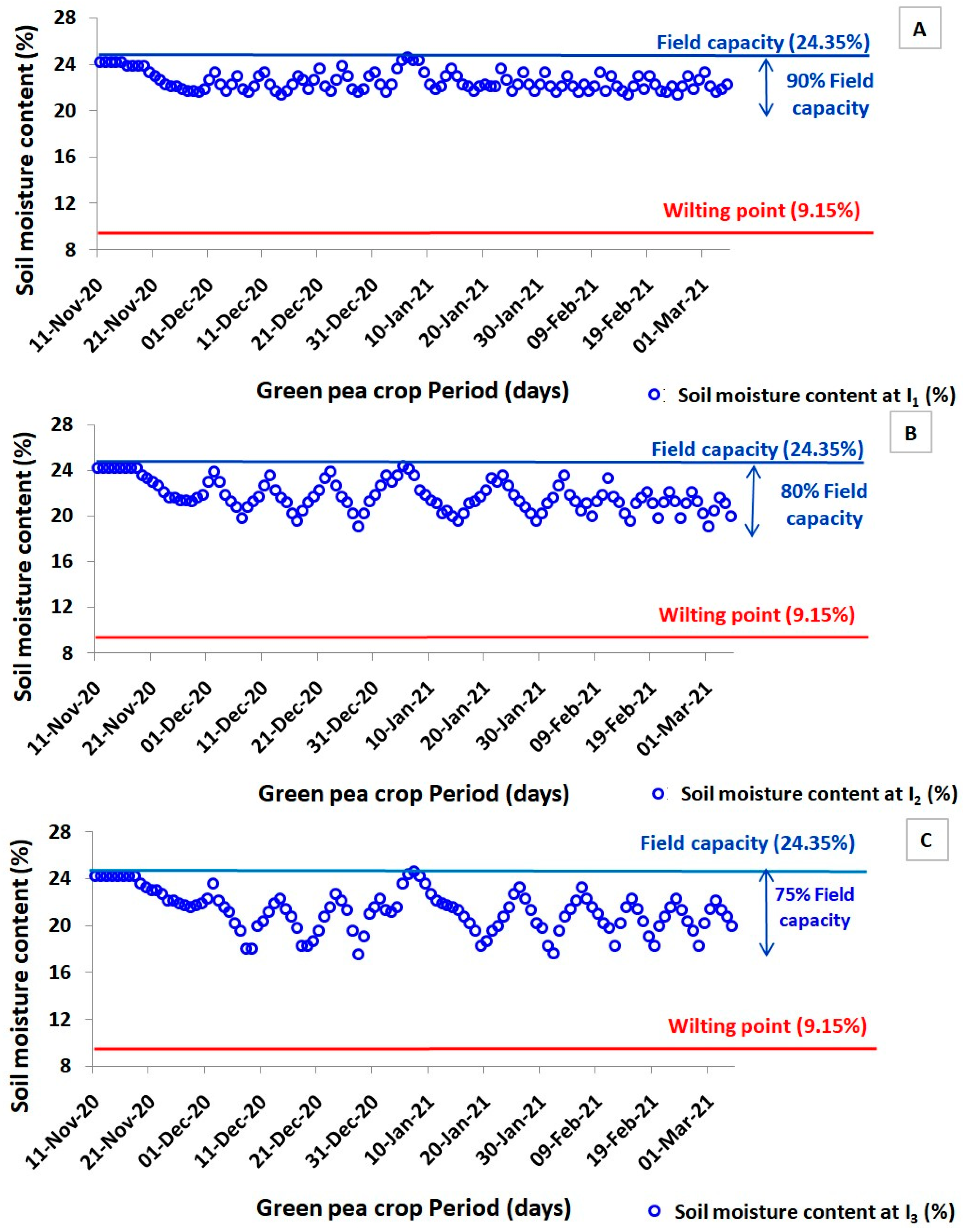
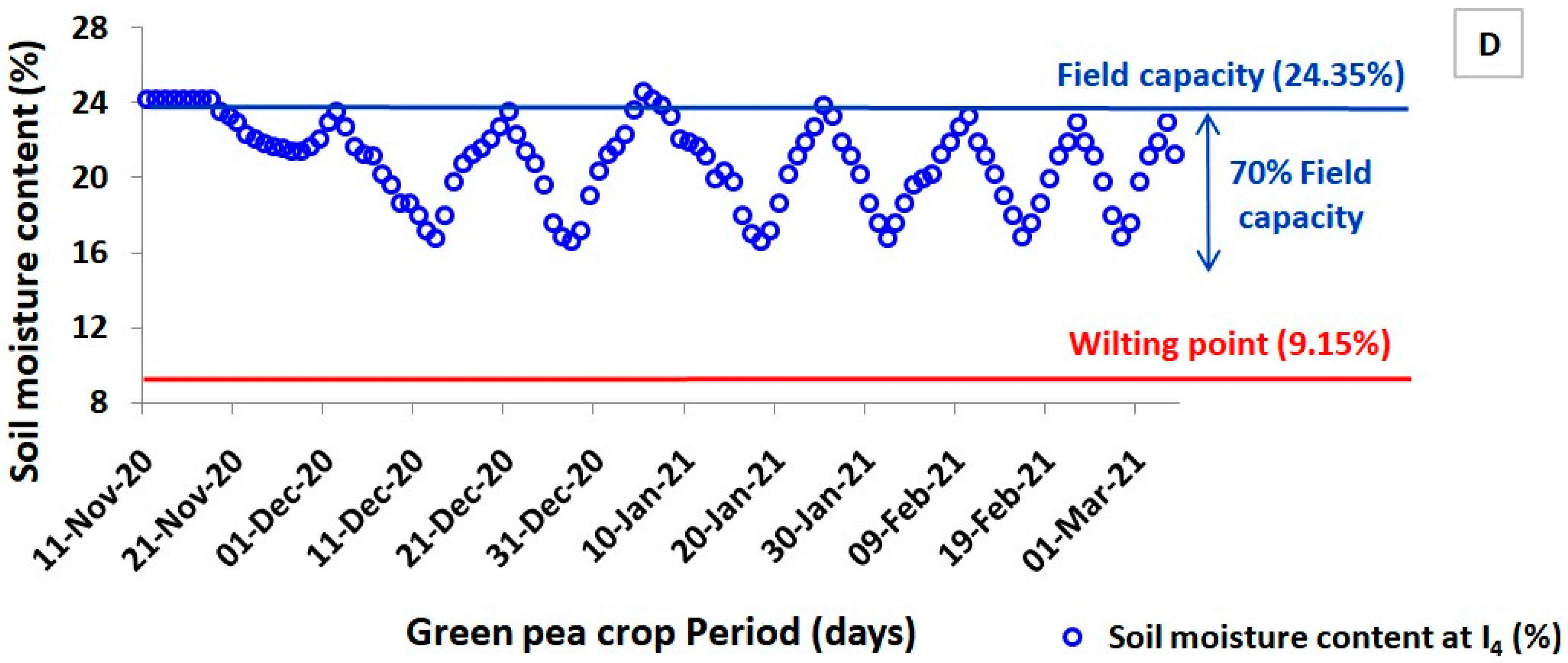

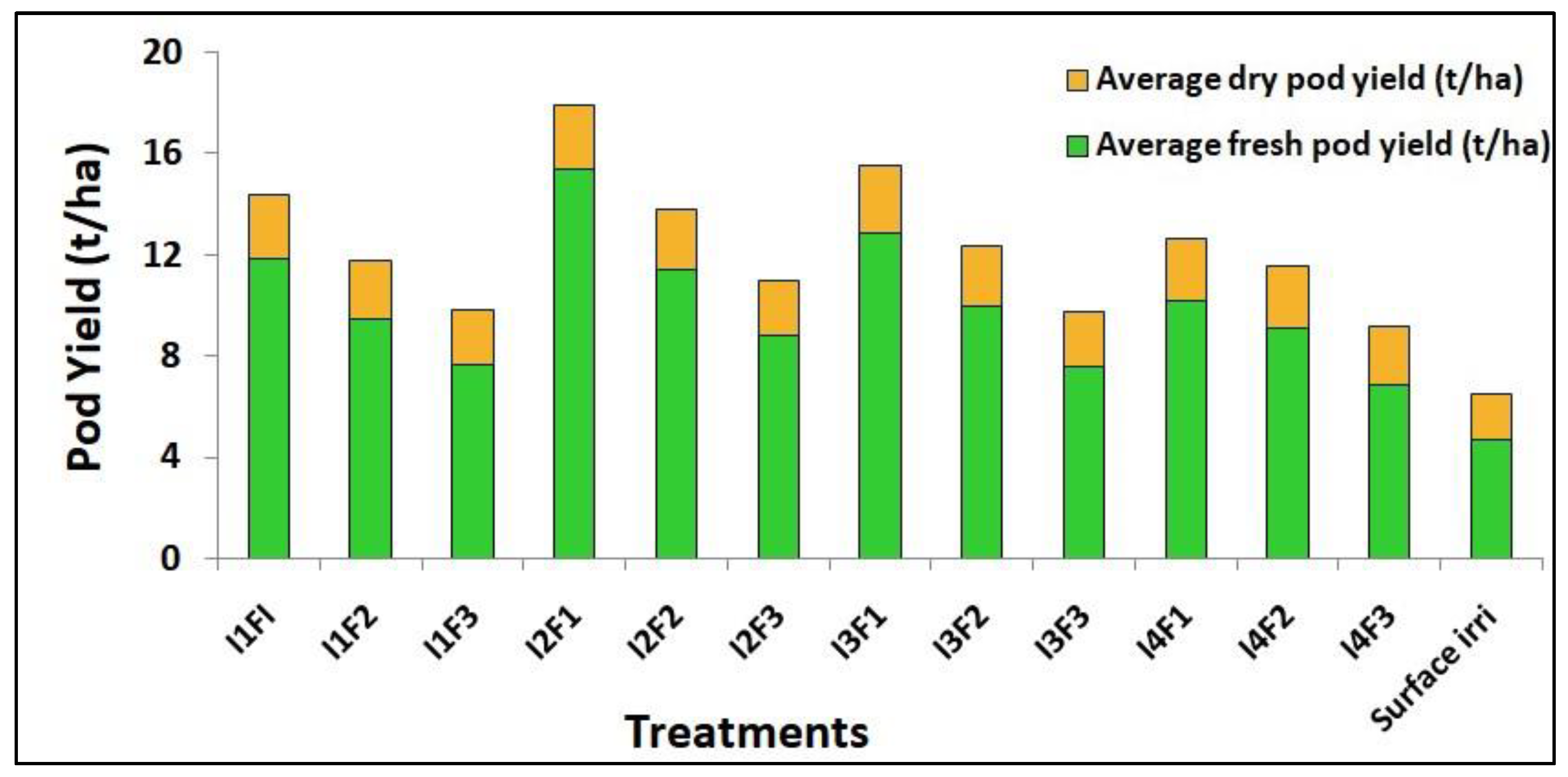
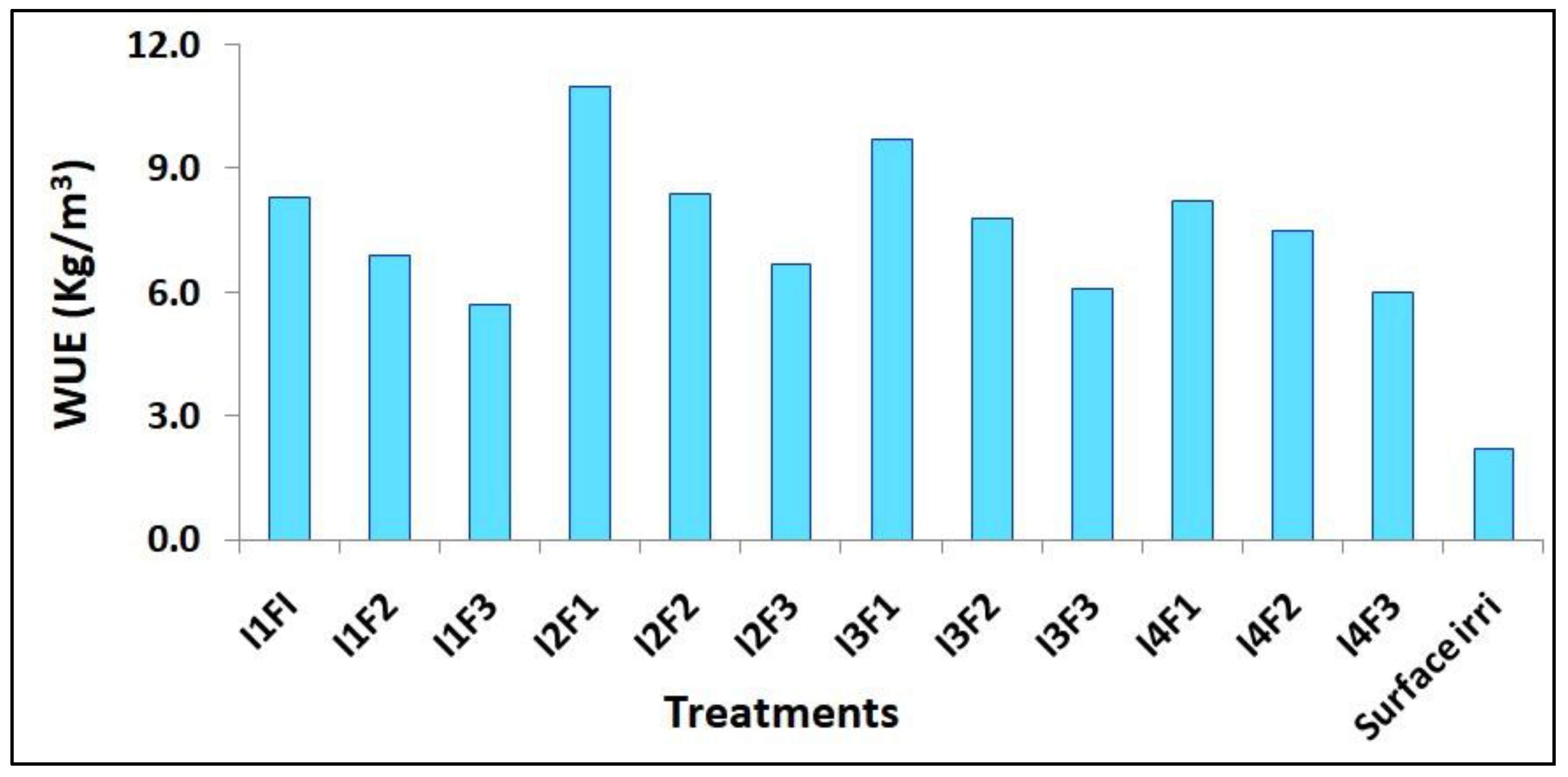
| Treatments | Plant Height (cm) | No. of Branches | Leaf Area Index | No. of Pods per Plant | Length of Pod (cm) | 100 Pods Weight (g) | No. of Seeds per Pod | Shelling (%) | Total Soluble Solids (°Brix) |
|---|---|---|---|---|---|---|---|---|---|
| I1FI | 80.2 | 6 | 1.4 | 32.1 | 7.7 | 422.5 | 7.0 | 45.3 | 17.4 |
| I1F2 | 74.0 | 5 | 1.0 | 24.7 | 7.1 | 418.1 | 6.7 | 43.0 | 16.9 |
| I1F3 | 68.8 | 4 | 0.9 | 17.3 | 6.9 | 400.3 | 6.0 | 40.8 | 16.4 |
| I2F1 | 84.8 | 6 | 1.3 | 35.3 | 7.8 | 454.2 | 7.5 | 49.2 | 19.5 |
| I2F2 | 78.3 | 6 | 0.9 | 27.7 | 7.4 | 421.3 | 6.7 | 43.6 | 19.0 |
| I2F3 | 71.9 | 5 | 0.8 | 18.7 | 7.1 | 411.3 | 6.3 | 41.0 | 16.7 |
| I3F1 | 81.3 | 5 | 1.1 | 31.5 | 7.3 | 434.0 | 6.9 | 45.9 | 19.3 |
| I3F2 | 76.3 | 4 | 0.8 | 22.9 | 7.4 | 414.4 | 6.5 | 43.4 | 18.8 |
| I3F3 | 65.8 | 4 | 0.8 | 18.2 | 7.3 | 407.6 | 6.1 | 38.9 | 17.4 |
| I4F1 | 79.3 | 5 | 0.9 | 27.3 | 7.4 | 430.0 | 6.8 | 44.5 | 18.7 |
| I4F2 | 69.2 | 4 | 0.8 | 19.1 | 7.4 | 415.7 | 6.3 | 42.6 | 18.1 |
| I4F3 | 64.3 | 4 | 0.7 | 16.0 | 7.2 | 395.1 | 5.9 | 35.1 | 16.0 |
| Particulars | Plant Height (cm) | No. of Branches | Leaf Area Index | No. Of Pods per Plant | Length of Pod (cm) | 100 Pods Weight (g) | No. of Seeds per Pod | Shelling (%) | Total Soluble Solids (°Brix) |
|---|---|---|---|---|---|---|---|---|---|
| Replication (df) | 2 | 2 | 2 | 2 | 2 | 2 | 2 | 2 | 2 |
| Replication (SS) | 0.17 | 0.14 | 0.01 | 3.45 | 1.18 | 30.06 | 0.22 | 7.66 | 0.21 |
| Replication (MSS) | 0.08 | 0.07 | 0.004 | 1.72 | 0.59 | 15.03 | 0.11 | 3.83 | 0.10 |
| Error (a) df | 6 | 6 | 6 | 6 | 6 | 6 | 6 | 6 | 6 |
| Error (a) SS | 34.57 | 8.65 | 0.03 | 14.96 | 0.44 | 286.9 | 0.29 | 10.64 | 1.75 |
| Error (a) MSS | 5.76 | 2.88 | 0.01 | 2.49 | 0.07 | 47.82 | 0.05 | 1.77 | 0.29 |
| Error (b) df | 16 | 16 | 16 | 16 | 16 | 16 | 16 | 16 | 16 |
| Error (b) SS | 40.14 | 0.77 | 0.07 | 33.54 | 1.33 | 767.56 | 0.77 | 18.64 | 3.73 |
| Error (b) MSS | 2.51 | 0.05 | 0.005 | 2.1 | 0.08 | 47.97 | 0.05 | 1.16 | 0.23 |
| Irrigation F (A) | 14.37 ** | 36.73 ** | 25.96 ** | 25.02 ** | NS | 9.82 ** | 7.76 * | 12.9 ** | 16.77 ** |
| Fertigation F (B) | 223.9 ** | 109.7 ** | 106.3 ** | 282.9 ** | 6.1 * | 62.9 ** | 58.1 ** | 137.2 ** | 63.9 ** |
| Interaction effect (A x B) | 2.97 * | 3.16 * | 4.12 * | 2.94 * | NS | 2.78 * | NS | 5.73 ** | 2.93 * |
| CV (a) | 3.22 | 5.71 | 7.70 | 6.51 | 3.69 | 1.65 | 3.36 | 3.11 | 3.02 |
| CV (b) | 2.13 | 4.48 | 7.19 | 5.97 | 3.93 | 1.65 | 3.35 | 2.52 | 2.70 |
| SEM (Irrigation) | 1.13 | 0.80 | 0.05 | 0.74 | 0.12 | 3.26 | 0.11 | 0.63 | 0.25 |
| SEM (Fertilizer) | 0.65 | 0.09 | 0.03 | 0.59 | 0.12 | 2.83 | 0.09 | 0.44 | 0.20 |
| SEM (Fertilizer at an Irrigation level) | 1.29 | 0.18 | 0.06 | 1.18 | 0.23 | 5.66 | 0.18 | 0.88 | 0.39 |
| SEM (Irrigation at a Fertilizer level) | 1.55 | 0.81 | 0.07 | 1.22 | 0.23 | 5.65 | 0.18 | 0.95 | 0.41 |
| LSD (Irrigation) (p < 0.05) | 2.77 | 1.96 | 0.12 | 1.82 | 0.31 | 7.98 | 0.26 | 1.53 | 0.62 |
| LSD (Fertilizer) (p < 0.05) | 1.37 | 0.19 | 0.06 | 1.25 | 0.24 | 5.99 | 0.19 | 0.93 | 0.42 |
| LSD (Fertilizer at an Irrigation level) (p < 0.05) | 2.74 | 0.39 | 0.12 | 2.51 | 0.49 | 11.99 | 0.39 | 1.86 | 0.83 |
| LSD (Irrigation at a Fertilizer level) (p < 0.05) | 3.79 | 1.99 | 0.16 | 2.98 | 0.55 | 13.83 | 0.45 | 2.33 | 1.00 |
| LSD (Irrigation) (p < 0.01) | 4.19 | 2.97 | 0.17 | 2.76 | 0.46 | 12.08 | 0.39 | 2.32 | 0.94 |
| LSD (Fertilizer) (p < 0.01) | 1.89 | 0.27 | 0.08 | 1.73 | 0.34 | 8.26 | 0.27 | 1.28 | 0.57 |
| LSD (Fertilizer at an Irrigation level) (p < 0.01) | 3.78 | 0.53 | 0.17 | 3.46 | 0.67 | 16.52 | 0.53 | 2.57 | 1.14 |
| LSD (Irrigation at a Fertilizer level) (p < 0.01) | 5.74 | 3.02 | 0.25 | 4.52 | 0.84 | 20.95 | 0.68 | 3.53 | 1.51 |
| Parameter | Minimum | Maximum | Mean | SD | SEM | CV (%) | Skewness | Kurtosis |
|---|---|---|---|---|---|---|---|---|
| Plant height (cm) | 64.3 | 84.8 | 74.5 | 6.56 | 1.89 | 8.8 | −0.13 | −1.16 |
| No. of branches | 4.0 | 6.0 | 4.8 | 0.84 | 0.24 | 17.3 | 0.35 | −1.45 |
| Leaf area index | 0.7 | 1.4 | 1.0 | 0.22 | 0.06 | 22.7 | 1.18 | 0.55 |
| No. of pods | 16.0 | 35.3 | 24.2 | 6.54 | 1.89 | 27.0 | 0.34 | −1.29 |
| Length of pod (cm) | 6.9 | 7.8 | 7.3 | 0.25 | 0.07 | 3.4 | 0.30 | 0.30 |
| 100 Pods weight (g) | 395.1 | 454.2 | 418.7 | 15.80 | 4.56 | 3.8 | 0.79 | 1.29 |
| No. of seeds/pod | 5.9 | 7.5 | 6.6 | 0.47 | 0.14 | 7.1 | 0.42 | −0.09 |
| TSS (°Brix) | 16.0 | 19.5 | 17.9 | 1.21 | 0.35 | 6.8 | −0.09 | −1.52 |
| Water used (mm) | 153.7 | 170.9 | 162.3 | 6.93 | 2.00 | 4.3 | 0.39 | −1.07 |
| WUE | 5.7 | 11.0 | 7.7 | 1.57 | 0.45 | 2.0 | 0.75 | 0.26 |
| Shelling (%) | 35.1 | 49.2 | 42.8 | 3.60 | 1.04 | 8.4 | −0.48 | 1.20 |
| Fresh pods (t/ha) | 6.8 | 15.4 | 10.1 | 2.45 | 0.71 | 24.3 | 0.81 | 0.58 |
| Dry pods (t/ha) | 2.2 | 2.6 | 2.4 | 0.13 | 0.04 | 5.5 | 0.15 | −0.77 |
| Yield (t/ha) | 9.2 | 17.9 | 12.5 | 2.57 | 0.74 | 20.6 | 0.78 | 0.30 |
| Parameters | Rep dof | Rep SS | Rep MSS | Error (a) df | Error (a) SS | Error (a) MS | Error (b) df | Error (b) SS | Error (b) MS |
|---|---|---|---|---|---|---|---|---|---|
| Yield | 2 | 3.71 | 1.85 | 6 | 5.59 | 0.93 | 16 | 9.48 | 0.59 |
| WUE | 2 | 1.38 | 0.69 | 6 | 2.16 | 0.36 | 16 | 3.51 | 0.22 |
| F (I) | F (F) | Interaction | Cv(a)(%) | Cv(b)(%) | SEM (I) | SEM (F) | SEM (F at I) | SEM (I at F) | |
| Yield | 16.7 ** | 135.2 ** | 3.5 * | 7.7 | 6.18 | 0.45 | 0.31 | 0.63 | 0.69 |
| WUE | 15.1** | 138.7 ** | 3.5 * | 7.8 | 6.09 | 0.28 | 0.19 | 0.38 | 0.42 |
| LSD (I) | LSD (F) | LSD (F at I) | LSD (I at F) | LSD (I) | LSD (F) | LSD (F at I) | LSD (I at F) | ||
| (p < 0.05) | (p < 0.05) | (p < 0.05) | (p < 0.05) | (p < 0.01) | (p < 0.01) | (p < 0.01) | (p < 0.01) | ||
| Yield | 1.11 | 0.67 | 1.33 | 1.68 | 1.69 | 0.92 | 1.84 | 2.54 | |
| WUE | 0.69 | 0.41 | 0.81 | 1.03 | 1.05 | 0.56 | 1.12 | 1.56 |
| Parameter | No. of Branches | Leaf Area Index | No. of Pods | Length of Pod | Pod Weight | No. of Seeds | Total Soluble Solids | Water-Use Efficiency | Shelling | Fresh Pods | Dry Pods | Yield |
|---|---|---|---|---|---|---|---|---|---|---|---|---|
| Plant height | 0.80 ** | 0.76 * | 0.96 ** | 0.66 * | 0.90 ** | 0.95 ** | 0.78 ** | 0.91 ** | 0.94 ** | 0.94 ** | 0.79 ** | 0.94 ** |
| No. of branches | 0.76 * | 0.83 ** | 0.60 | 0.71 * | 0.82 ** | 0.44 | 0.70 * | 0.69 * | 0.78 ** | 0.53 | 0.77 ** | |
| Leaf area index | 0.86 ** | 0.64 * | 0.71 * | 0.83 ** | 0.36 | 0.69 * | 0.77 ** | 0.79 ** | 0.65 * | 0.79 ** | ||
| No. of pods | 0.74 * | 0.91 ** | 0.97 ** | 0.73 * | 0.92 ** | 0.90 ** | 0.95 ** | 0.84 ** | 0.96 ** | |||
| Length of pod | 0.72 * | 0.76 * | 0.65* | 0.77 ** | 0.65 * | 0.75 * | 0.71 * | 0.76 * | ||||
| Pod weight | 0.95 ** | 0.82 ** | 0.95 ** | 0.93 ** | 0.95 ** | 0.74 * | 0.95 ** | |||||
| No. of seeds | 0.73 * | 0.92 ** | 0.93 ** | 0.96 ** | 0.77 ** | 0.96 ** | ||||||
| Total soluble solids | 0.87 ** | 0.79 ** | 0.80 ** | 0.75 * | 0.81 ** | |||||||
| Water-use efficiency | 0.89 ** | 0.98 ** | 0.87 ** | 0.98 ** | ||||||||
| Shelling | 0.93 ** | 0.74 * | 0.92 ** | |||||||||
| Fresh pods | 0.82 ** | 0.98 ** | ||||||||||
| Dry pods | 0.84 ** |
| Model | Regression Model of Pea Yield through Different Parameters | R2 | SEM |
|---|---|---|---|
| 1 | Y = −1.183 ** + 0.979 ** (FP) + 1.589 ** (DP) | 0.980 ** | 0.044 |
| 2 | Y = −29.271 + 0.050 (PH) + 0.29 (NOB) + 3.269 (LAI) + 0.026 (NOP) + 0.246 (LOP) + 0.056 (PW) − 0.440 (NOS) + 0.594 (TSS) | 0.962 * | 0.958 |
Publisher’s Note: MDPI stays neutral with regard to jurisdictional claims in published maps and institutional affiliations. |
© 2022 by the authors. Licensee MDPI, Basel, Switzerland. This article is an open access article distributed under the terms and conditions of the Creative Commons Attribution (CC BY) license (https://creativecommons.org/licenses/by/4.0/).
Share and Cite
K., A.; M., S.; Franco, D.; V. K., P.; J., R.; G. R., M.S. Real Time Soil Moisture (RTSM) Based Irrigation Scheduling to Improve Yield and Water-Use Efficiency of Green Pea (Pisum sativum L.) Grown in North India. Agronomy 2022, 12, 278. https://doi.org/10.3390/agronomy12020278
K. A, M. S, Franco D, V. K. P, J. R, G. R. MS. Real Time Soil Moisture (RTSM) Based Irrigation Scheduling to Improve Yield and Water-Use Efficiency of Green Pea (Pisum sativum L.) Grown in North India. Agronomy. 2022; 12(2):278. https://doi.org/10.3390/agronomy12020278
Chicago/Turabian StyleK., Arunadevi, Singh M., Denny Franco, Prajapati V. K., Ramachandran J., and Maruthi Sankar G. R. 2022. "Real Time Soil Moisture (RTSM) Based Irrigation Scheduling to Improve Yield and Water-Use Efficiency of Green Pea (Pisum sativum L.) Grown in North India" Agronomy 12, no. 2: 278. https://doi.org/10.3390/agronomy12020278
APA StyleK., A., M., S., Franco, D., V. K., P., J., R., & G. R., M. S. (2022). Real Time Soil Moisture (RTSM) Based Irrigation Scheduling to Improve Yield and Water-Use Efficiency of Green Pea (Pisum sativum L.) Grown in North India. Agronomy, 12(2), 278. https://doi.org/10.3390/agronomy12020278






